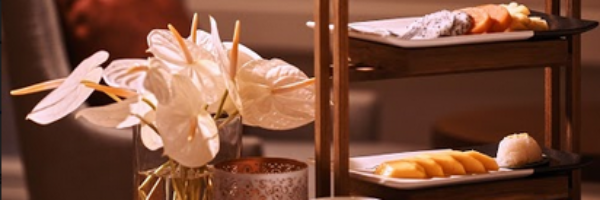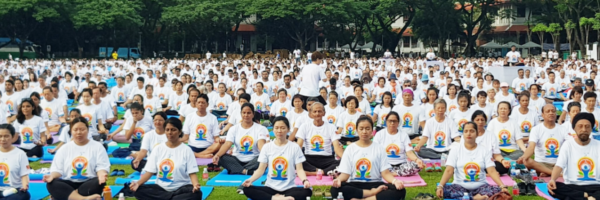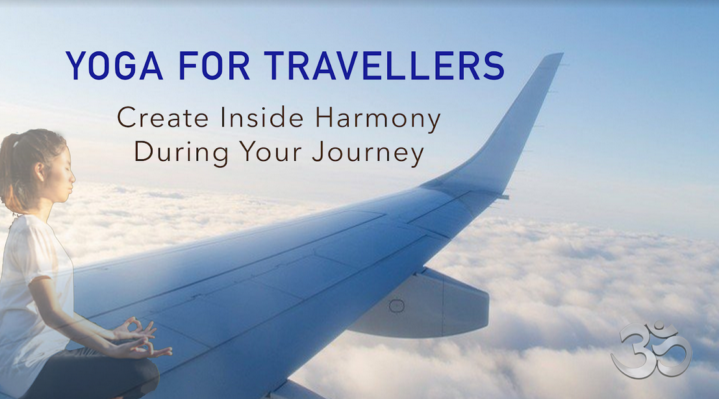
Yoga for travellers
Technology and travelling have made our world a global village. This phenomenon is called globalisation. It is a process of interconnection between people around the globe. We have access to all information worldwide and we can quickly and easily travel wherever we want. People are coming closer and sharing their knowledge and experiences. It has always been exciting for people to travel around the world for wanderlust, getting new ideas, discovering new cultures, education, making
But there are two sides to everything. Travelling, especially excessively, has some adverse impact on your health. Frequent travelling and or travelling through more than 4 time zones are not always pleasant or fun. The difference in the quality of water, air, food and a sudden change of weather and temperature is not easy for our bodies to adjust. – Following circumstances significantly lead to physical and behavioural health risks such as:
- jet lag, our natural body clock gets confused
- deep vein thrombosis
- viral infections
- less or no physical activity or exercise
- trouble with sleeping, through late nights, early mornings, and terrible eating habits
- indigestion and constipation
- obesity
- alcohol dependency, to compensate stress
- increased consumption of cigarettes, to compensate stress
- restlessness
- depression
- lose our sensations
- more stiffness than usual, aches and pain become worse
- thirsty and tired most of the time.
Disruption of our body cycle is linked to h
Staying healthy
Most of the time we cannot cut back on business travel. Thus, to manage these health issues, we tend to neglect the symptoms or rely on medicine. So how to manage the potential hazards of too much travelling with a holistic approach and without medicine? Stress management, mindfulness and gentle yoga movements including conscious breathing practices are important parts of taking care of ourself while away. Depending on your time and favourite praxis choose one, two or all practices to stay fit and healthy.
PAWANMUKASANA Series 1 (PW1) *
These series of practices are divided into 3 groups and allow practitioners of all physical aptitudes to benefit from its healing properties.
PW1 is a sequence of anti-rheumatic asanas.
PW2 is a sequence of anti-gastric asanas.
PW3 is a sequence of
To manage health problems related to frequent travelling the PW1 series is the easiest, safest, time saving and most beneficial remedy. It prevents all joints, muscles and nerves from stiffness and encourages blood and prana circulation to every cell and tissue. The sequence consists of rotation and bending of joints and stretching of muscles as well as nerves. It gives profound relaxation to the heart, muscles, nerves, brain cells and mind by encouraging smooth blood and prana circulation.
Everyone can do this practice, without any exception. Even people with health issues or injuries can practice it. There are no negative side effects or any harm even if you do the practice incorrectly. People having high blood pressure, heart ailments, diabetes, stress, cramp tightness in muscles and nerves benefit from this practice. This practice doesn’t require a yoga mat. It can be done on a chair or bed and at any time of the day. Recommended amount: 10 – 20 rounds each side (left and right).
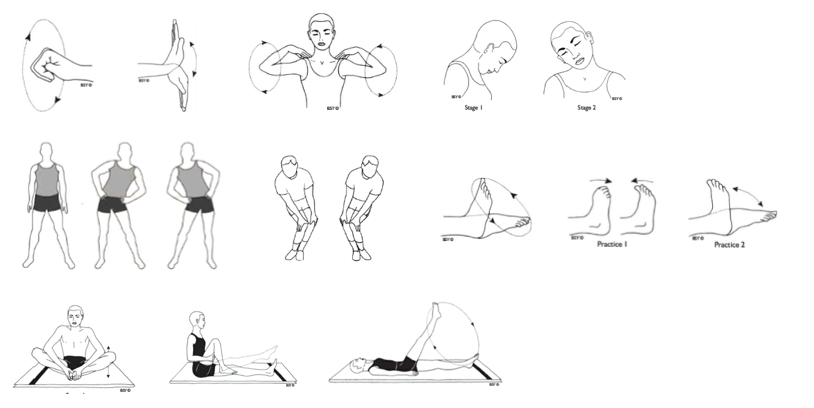
Sun salutation
Regular yoga practitioners and those who prefer a slightly physical approach can choose the sunsalutation sequence to stay fit. Depending on the pace and the repetition of rounds this practice is a great cardio workout as well. Advanced practitioners go with breath awareness, beginners do it with normal breathing. Sun salutation rounds are an effective way of loosening up, stretching, massaging and toning all the joints, muscles and internal organs of the body. Its versatility and application make it one of the most useful methods of inducing a healthy, vigorous and active life.
For this practice morning time is the best to increase the energy level for the whole day.
Precaution: People with heart problems, high blood pressure or any severe injuries or surgery should
refrain from this practice.
Recommended amount: 3-6 rounds. After the sun salutation rounds relax in Savasana for 3 min.

Recommended short asana travel sequence
These movements are particularly useful for those who spend a lot of time sedentary, have stiffness or pain in the back. These movements improve body posture, stretching the whole body, strengthen the muscles, and increase oxygenation and lung capacity. They are great for the internal organs. They massage and stretch the abdomen organs (like stomach, liver, kidney and pancreas) and increase bowel movement.
If you have more time add first some backward and later some forward bending. If you want, you can add shoulder stand and those who cannot do shoulder stand, can do bridge pose. Add as last asana one leg raise pose and finish your practice with savasana. Do each posture 10 times each side or counts.
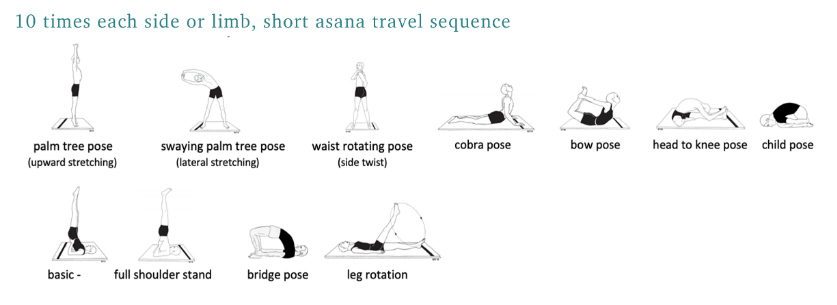
Pranayama
People who don’t like physical practices, can do pranayama on a chair or bed. Real yoga starts with pranayama and not as most practitioner think with asanas. Asanas are just a warm-up for the advanced practice of pranayama. The different pranayama techniques have variant purposes and benefits. But overall, they balance the body clock, increase the capacity of breath, make us feel centred and focused, and control our mental, emotional and physical wellbeing.
Kapalbhati recharge the whole respiratory system and is a great detox practice. It cleans the lungs and the frontal lobe (sinus area). It is very beneficial for the lungs and the digestive system. It is ideal to do it in a cold climate, because it creates heat in the body and energises. So, you feel more alert and active throughout the day.
Precaution: Kapalbhati should be performed on an empty stomach. People with high blood pressure, acidity, vertigo, epilepsy, stroke, gastric ulcer, or who have gone through any surgery recently should refrain from this practice. Pregnant woman should not do this practice.
Recommended amount: 30 – 50 breaths in one round (do 3 rounds)
Sheetkari is a cooling practice and ideal to do in a hot climate. It cools down the body and mind. It is very good for people with high blood pressure, acidity, severe heart problem and continual sensation of thirst. It should be done inside.
Recommended amount: 10 – 20 breaths
Nadi Shodana is one of the best practices for everybody even for people with severe illness. It recharges each and every cell to control the mind and our emotions and to make us feel calm, quiet, peaceful and centred. It is the most effective healing method in yoga.
Recommended amount: 10-20 rounds according to your time.
Yoga Nidra/relaxation
This is true meditation where there is nothing to do but to ‘notice and witness’ — your feelings, thoughts, breath and body parts. Yoga Nidra brings awareness to every level of being. It includes the body, energy and breath, mind and emotions and this in return, allows each level to relax. Best of all, 20 minutes of Yoga Nidra is said to be equivalent to three hours of sleep! The best time to do it is in the afternoon (after your meetings) or night time before going to bed. All you need is a comfortable place to lie down.
– Scan your body, gradually move your awareness through your body (from top to toes right side and from toes to top left side and from back to front side).
– Rotate and visualise each and every part of your body.
– Experience sensations in single body parts.
– Bring attention to your breathing (do deep abdominal breathing).
– Observe the natural flow of air in the nostrils, throat and rib cage and the rise and fall of the abdomen with each breath. Count backward on your breath from 11 to 1.
– Recall your day mentally, all your activities from the morning to the evening. That gives deep relaxation.
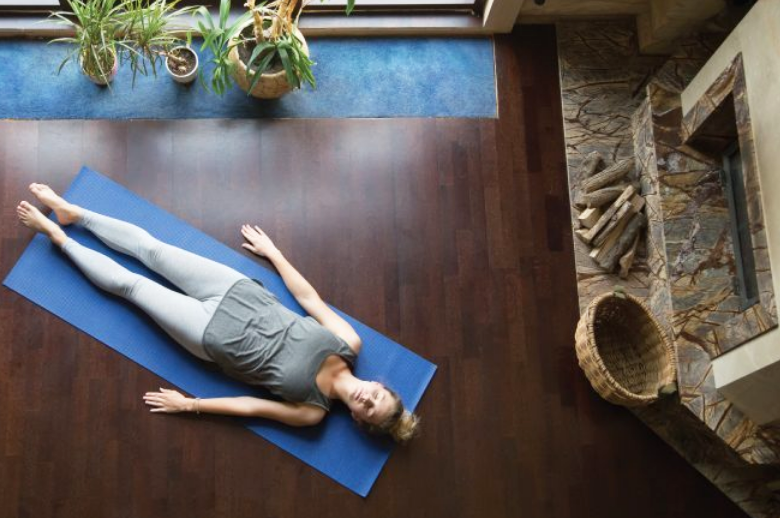
If you feel it is difficult to follow your own instructions, then it might help being guided by an instructor’s voice. Follow the YouTube link below! This Yoga Nidra instruction is the one from my Guru and from the first Yoga University in India, “Bihar School of Yoga”. Search on YouTube for: “Yoga Nidra – Beginners by Swami Niranjanananda Saraswati”
https://www.youtube.com/watch?v=E4fO1istXvo&t=4s
AUM Mantra chanting
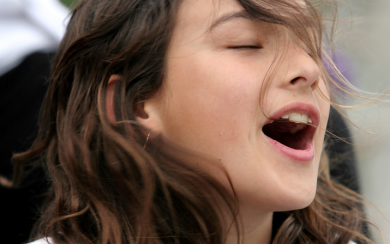
All mantras have intense physical and mental benefits. They relieve stress and tensions. The rhythm and sound of the chanting moves energy through the body. The movement of energy regulates the chemicals in our brains. Mantras enhance positive alpha waves which give deep mental relaxation. The easiest and most beneficial mantra is the ‘AUM’ Mantra. For this as well, if you feel uncomfortable to hear your own voice alone, you can chant synchronic with one of the many Aum mantras you can find on YouTube. It can be done in the sitting position on a chair or on the bed. Recommended amount: 5-11 times.


